Lifting of the Corporate Veil
VerifiedAdded on 2023/02/01
|9
|3628
|31
AI Summary
This article discusses the concept of lifting the corporate veil and its implications in tort law. It explores the circumstances under which a parent company can be held liable for the actions of its subsidiary. The article also examines the relationship between corporate and tort law and the limitations of the corporate shield. The case of Chandler v Vape plc is used as an example to illustrate these concepts. Overall, the article provides a comprehensive understanding of the topic.
Contribute Materials
Your contribution can guide someone’s learning journey. Share your
documents today.
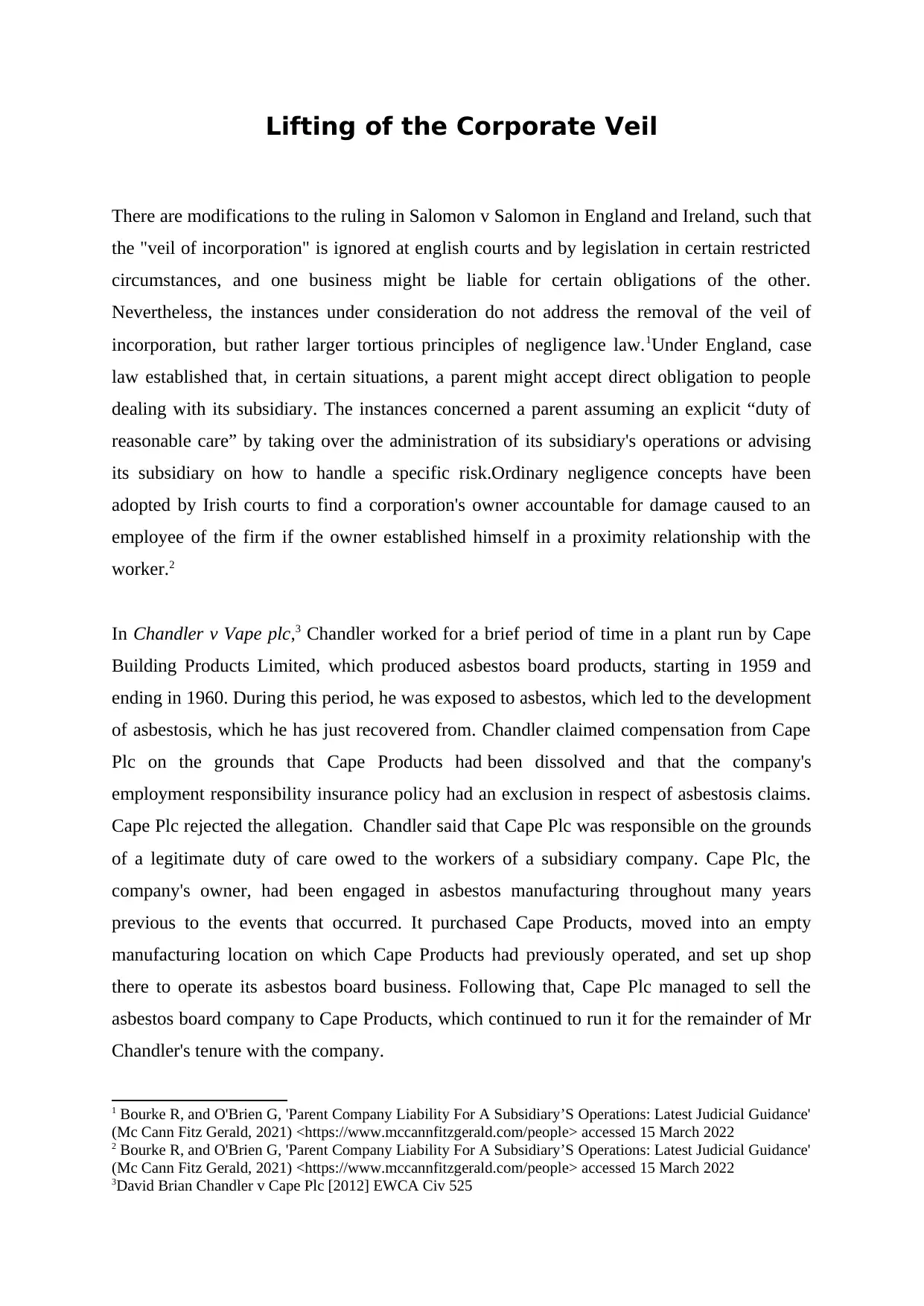
Lifting of the Corporate Veil
There are modifications to the ruling in Salomon v Salomon in England and Ireland, such that
the "veil of incorporation" is ignored at english courts and by legislation in certain restricted
circumstances, and one business might be liable for certain obligations of the other.
Nevertheless, the instances under consideration do not address the removal of the veil of
incorporation, but rather larger tortious principles of negligence law.1Under England, case
law established that, in certain situations, a parent might accept direct obligation to people
dealing with its subsidiary. The instances concerned a parent assuming an explicit “duty of
reasonable care” by taking over the administration of its subsidiary's operations or advising
its subsidiary on how to handle a specific risk.Ordinary negligence concepts have been
adopted by Irish courts to find a corporation's owner accountable for damage caused to an
employee of the firm if the owner established himself in a proximity relationship with the
worker.2
In Chandler v Vape plc,3 Chandler worked for a brief period of time in a plant run by Cape
Building Products Limited, which produced asbestos board products, starting in 1959 and
ending in 1960. During this period, he was exposed to asbestos, which led to the development
of asbestosis, which he has just recovered from. Chandler claimed compensation from Cape
Plc on the grounds that Cape Products had been dissolved and that the company's
employment responsibility insurance policy had an exclusion in respect of asbestosis claims.
Cape Plc rejected the allegation. Chandler said that Cape Plc was responsible on the grounds
of a legitimate duty of care owed to the workers of a subsidiary company. Cape Plc, the
company's owner, had been engaged in asbestos manufacturing throughout many years
previous to the events that occurred. It purchased Cape Products, moved into an empty
manufacturing location on which Cape Products had previously operated, and set up shop
there to operate its asbestos board business. Following that, Cape Plc managed to sell the
asbestos board company to Cape Products, which continued to run it for the remainder of Mr
Chandler's tenure with the company.
1 Bourke R, and O'Brien G, 'Parent Company Liability For A Subsidiary’S Operations: Latest Judicial Guidance'
(Mc Cann Fitz Gerald, 2021) <https://www.mccannfitzgerald.com/people> accessed 15 March 2022
2 Bourke R, and O'Brien G, 'Parent Company Liability For A Subsidiary’S Operations: Latest Judicial Guidance'
(Mc Cann Fitz Gerald, 2021) <https://www.mccannfitzgerald.com/people> accessed 15 March 2022
3David Brian Chandler v Cape Plc [2012] EWCA Civ 525
There are modifications to the ruling in Salomon v Salomon in England and Ireland, such that
the "veil of incorporation" is ignored at english courts and by legislation in certain restricted
circumstances, and one business might be liable for certain obligations of the other.
Nevertheless, the instances under consideration do not address the removal of the veil of
incorporation, but rather larger tortious principles of negligence law.1Under England, case
law established that, in certain situations, a parent might accept direct obligation to people
dealing with its subsidiary. The instances concerned a parent assuming an explicit “duty of
reasonable care” by taking over the administration of its subsidiary's operations or advising
its subsidiary on how to handle a specific risk.Ordinary negligence concepts have been
adopted by Irish courts to find a corporation's owner accountable for damage caused to an
employee of the firm if the owner established himself in a proximity relationship with the
worker.2
In Chandler v Vape plc,3 Chandler worked for a brief period of time in a plant run by Cape
Building Products Limited, which produced asbestos board products, starting in 1959 and
ending in 1960. During this period, he was exposed to asbestos, which led to the development
of asbestosis, which he has just recovered from. Chandler claimed compensation from Cape
Plc on the grounds that Cape Products had been dissolved and that the company's
employment responsibility insurance policy had an exclusion in respect of asbestosis claims.
Cape Plc rejected the allegation. Chandler said that Cape Plc was responsible on the grounds
of a legitimate duty of care owed to the workers of a subsidiary company. Cape Plc, the
company's owner, had been engaged in asbestos manufacturing throughout many years
previous to the events that occurred. It purchased Cape Products, moved into an empty
manufacturing location on which Cape Products had previously operated, and set up shop
there to operate its asbestos board business. Following that, Cape Plc managed to sell the
asbestos board company to Cape Products, which continued to run it for the remainder of Mr
Chandler's tenure with the company.
1 Bourke R, and O'Brien G, 'Parent Company Liability For A Subsidiary’S Operations: Latest Judicial Guidance'
(Mc Cann Fitz Gerald, 2021) <https://www.mccannfitzgerald.com/people> accessed 15 March 2022
2 Bourke R, and O'Brien G, 'Parent Company Liability For A Subsidiary’S Operations: Latest Judicial Guidance'
(Mc Cann Fitz Gerald, 2021) <https://www.mccannfitzgerald.com/people> accessed 15 March 2022
3David Brian Chandler v Cape Plc [2012] EWCA Civ 525
Secure Best Marks with AI Grader
Need help grading? Try our AI Grader for instant feedback on your assignments.
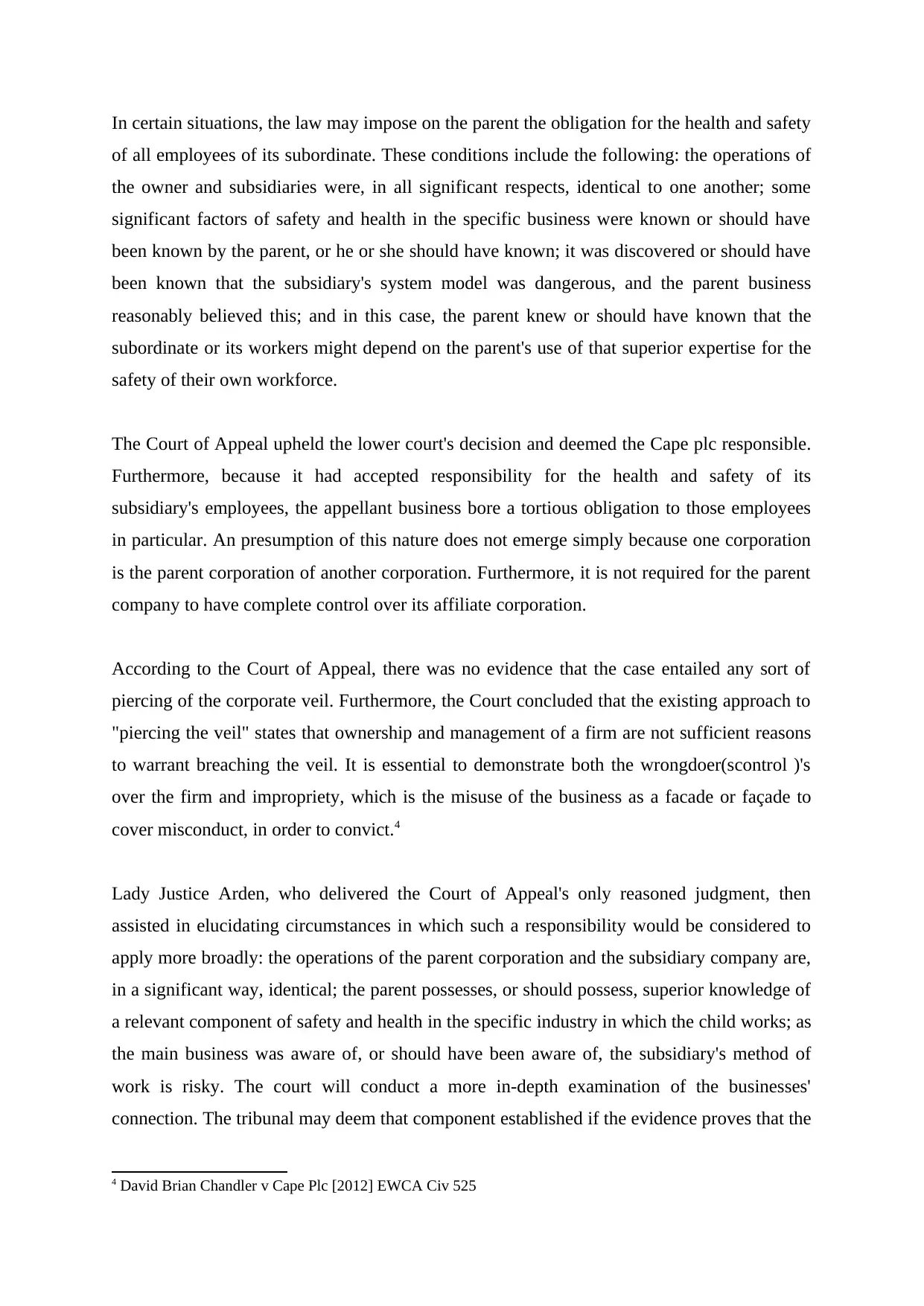
In certain situations, the law may impose on the parent the obligation for the health and safety
of all employees of its subordinate. These conditions include the following: the operations of
the owner and subsidiaries were, in all significant respects, identical to one another; some
significant factors of safety and health in the specific business were known or should have
been known by the parent, or he or she should have known; it was discovered or should have
been known that the subsidiary's system model was dangerous, and the parent business
reasonably believed this; and in this case, the parent knew or should have known that the
subordinate or its workers might depend on the parent's use of that superior expertise for the
safety of their own workforce.
The Court of Appeal upheld the lower court's decision and deemed the Cape plc responsible.
Furthermore, because it had accepted responsibility for the health and safety of its
subsidiary's employees, the appellant business bore a tortious obligation to those employees
in particular. An presumption of this nature does not emerge simply because one corporation
is the parent corporation of another corporation. Furthermore, it is not required for the parent
company to have complete control over its affiliate corporation.
According to the Court of Appeal, there was no evidence that the case entailed any sort of
piercing of the corporate veil. Furthermore, the Court concluded that the existing approach to
"piercing the veil" states that ownership and management of a firm are not sufficient reasons
to warrant breaching the veil. It is essential to demonstrate both the wrongdoer(scontrol )'s
over the firm and impropriety, which is the misuse of the business as a facade or façade to
cover misconduct, in order to convict.4
Lady Justice Arden, who delivered the Court of Appeal's only reasoned judgment, then
assisted in elucidating circumstances in which such a responsibility would be considered to
apply more broadly: the operations of the parent corporation and the subsidiary company are,
in a significant way, identical; the parent possesses, or should possess, superior knowledge of
a relevant component of safety and health in the specific industry in which the child works; as
the main business was aware of, or should have been aware of, the subsidiary's method of
work is risky. The court will conduct a more in-depth examination of the businesses'
connection. The tribunal may deem that component established if the evidence proves that the
4 David Brian Chandler v Cape Plc [2012] EWCA Civ 525
of all employees of its subordinate. These conditions include the following: the operations of
the owner and subsidiaries were, in all significant respects, identical to one another; some
significant factors of safety and health in the specific business were known or should have
been known by the parent, or he or she should have known; it was discovered or should have
been known that the subsidiary's system model was dangerous, and the parent business
reasonably believed this; and in this case, the parent knew or should have known that the
subordinate or its workers might depend on the parent's use of that superior expertise for the
safety of their own workforce.
The Court of Appeal upheld the lower court's decision and deemed the Cape plc responsible.
Furthermore, because it had accepted responsibility for the health and safety of its
subsidiary's employees, the appellant business bore a tortious obligation to those employees
in particular. An presumption of this nature does not emerge simply because one corporation
is the parent corporation of another corporation. Furthermore, it is not required for the parent
company to have complete control over its affiliate corporation.
According to the Court of Appeal, there was no evidence that the case entailed any sort of
piercing of the corporate veil. Furthermore, the Court concluded that the existing approach to
"piercing the veil" states that ownership and management of a firm are not sufficient reasons
to warrant breaching the veil. It is essential to demonstrate both the wrongdoer(scontrol )'s
over the firm and impropriety, which is the misuse of the business as a facade or façade to
cover misconduct, in order to convict.4
Lady Justice Arden, who delivered the Court of Appeal's only reasoned judgment, then
assisted in elucidating circumstances in which such a responsibility would be considered to
apply more broadly: the operations of the parent corporation and the subsidiary company are,
in a significant way, identical; the parent possesses, or should possess, superior knowledge of
a relevant component of safety and health in the specific industry in which the child works; as
the main business was aware of, or should have been aware of, the subsidiary's method of
work is risky. The court will conduct a more in-depth examination of the businesses'
connection. The tribunal may deem that component established if the evidence proves that the
4 David Brian Chandler v Cape Plc [2012] EWCA Civ 525
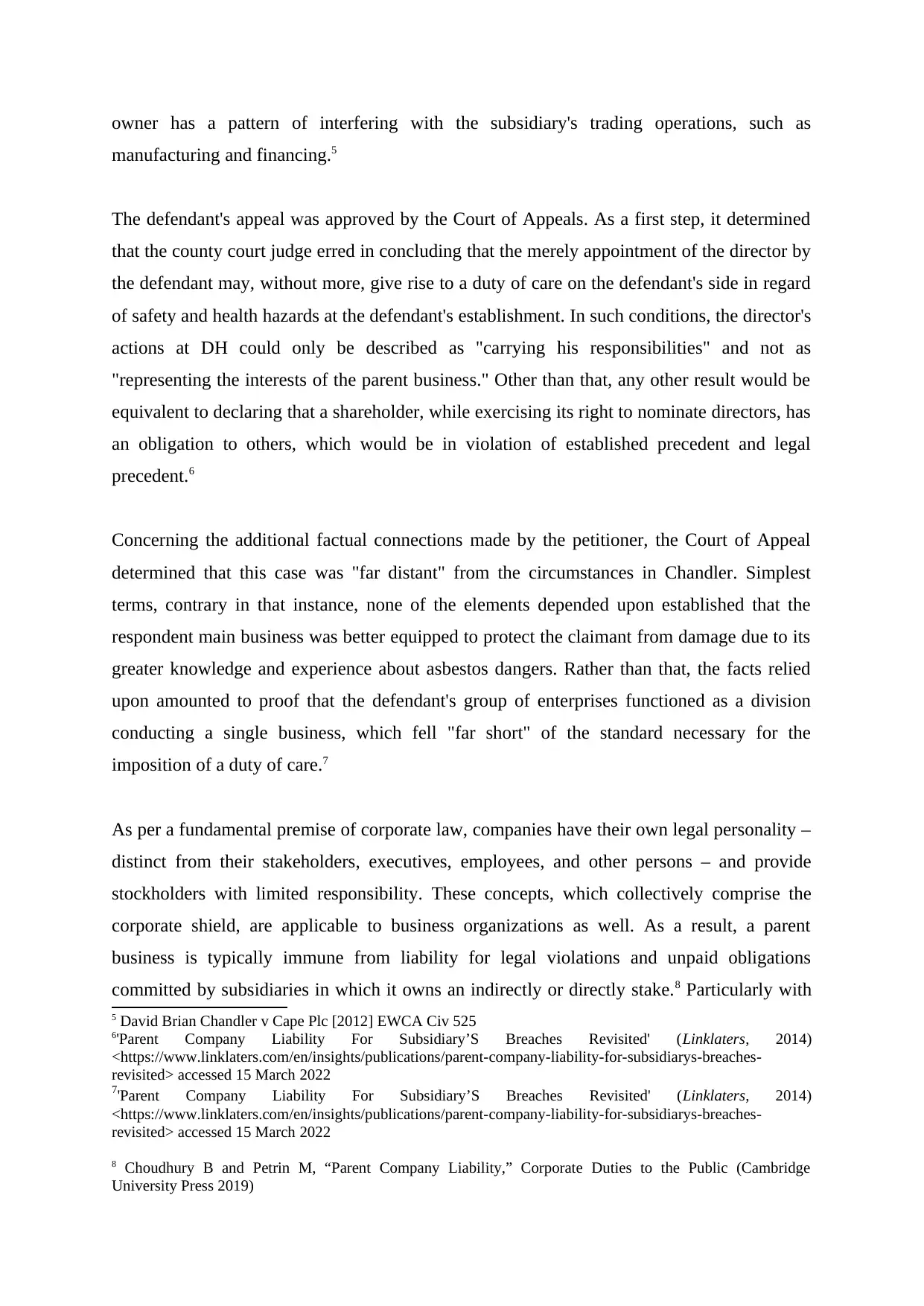
owner has a pattern of interfering with the subsidiary's trading operations, such as
manufacturing and financing.5
The defendant's appeal was approved by the Court of Appeals. As a first step, it determined
that the county court judge erred in concluding that the merely appointment of the director by
the defendant may, without more, give rise to a duty of care on the defendant's side in regard
of safety and health hazards at the defendant's establishment. In such conditions, the director's
actions at DH could only be described as "carrying his responsibilities" and not as
"representing the interests of the parent business." Other than that, any other result would be
equivalent to declaring that a shareholder, while exercising its right to nominate directors, has
an obligation to others, which would be in violation of established precedent and legal
precedent.6
Concerning the additional factual connections made by the petitioner, the Court of Appeal
determined that this case was "far distant" from the circumstances in Chandler. Simplest
terms, contrary in that instance, none of the elements depended upon established that the
respondent main business was better equipped to protect the claimant from damage due to its
greater knowledge and experience about asbestos dangers. Rather than that, the facts relied
upon amounted to proof that the defendant's group of enterprises functioned as a division
conducting a single business, which fell "far short" of the standard necessary for the
imposition of a duty of care.7
As per a fundamental premise of corporate law, companies have their own legal personality –
distinct from their stakeholders, executives, employees, and other persons – and provide
stockholders with limited responsibility. These concepts, which collectively comprise the
corporate shield, are applicable to business organizations as well. As a result, a parent
business is typically immune from liability for legal violations and unpaid obligations
committed by subsidiaries in which it owns an indirectly or directly stake.8 Particularly with
5 David Brian Chandler v Cape Plc [2012] EWCA Civ 525
6'Parent Company Liability For Subsidiary’S Breaches Revisited' (Linklaters, 2014)
<https://www.linklaters.com/en/insights/publications/parent-company-liability-for-subsidiarys-breaches-
revisited> accessed 15 March 2022
7'Parent Company Liability For Subsidiary’S Breaches Revisited' (Linklaters, 2014)
<https://www.linklaters.com/en/insights/publications/parent-company-liability-for-subsidiarys-breaches-
revisited> accessed 15 March 2022
8 Choudhury B and Petrin M, “Parent Company Liability,” Corporate Duties to the Public (Cambridge
University Press 2019)
manufacturing and financing.5
The defendant's appeal was approved by the Court of Appeals. As a first step, it determined
that the county court judge erred in concluding that the merely appointment of the director by
the defendant may, without more, give rise to a duty of care on the defendant's side in regard
of safety and health hazards at the defendant's establishment. In such conditions, the director's
actions at DH could only be described as "carrying his responsibilities" and not as
"representing the interests of the parent business." Other than that, any other result would be
equivalent to declaring that a shareholder, while exercising its right to nominate directors, has
an obligation to others, which would be in violation of established precedent and legal
precedent.6
Concerning the additional factual connections made by the petitioner, the Court of Appeal
determined that this case was "far distant" from the circumstances in Chandler. Simplest
terms, contrary in that instance, none of the elements depended upon established that the
respondent main business was better equipped to protect the claimant from damage due to its
greater knowledge and experience about asbestos dangers. Rather than that, the facts relied
upon amounted to proof that the defendant's group of enterprises functioned as a division
conducting a single business, which fell "far short" of the standard necessary for the
imposition of a duty of care.7
As per a fundamental premise of corporate law, companies have their own legal personality –
distinct from their stakeholders, executives, employees, and other persons – and provide
stockholders with limited responsibility. These concepts, which collectively comprise the
corporate shield, are applicable to business organizations as well. As a result, a parent
business is typically immune from liability for legal violations and unpaid obligations
committed by subsidiaries in which it owns an indirectly or directly stake.8 Particularly with
5 David Brian Chandler v Cape Plc [2012] EWCA Civ 525
6'Parent Company Liability For Subsidiary’S Breaches Revisited' (Linklaters, 2014)
<https://www.linklaters.com/en/insights/publications/parent-company-liability-for-subsidiarys-breaches-
revisited> accessed 15 March 2022
7'Parent Company Liability For Subsidiary’S Breaches Revisited' (Linklaters, 2014)
<https://www.linklaters.com/en/insights/publications/parent-company-liability-for-subsidiarys-breaches-
revisited> accessed 15 March 2022
8 Choudhury B and Petrin M, “Parent Company Liability,” Corporate Duties to the Public (Cambridge
University Press 2019)
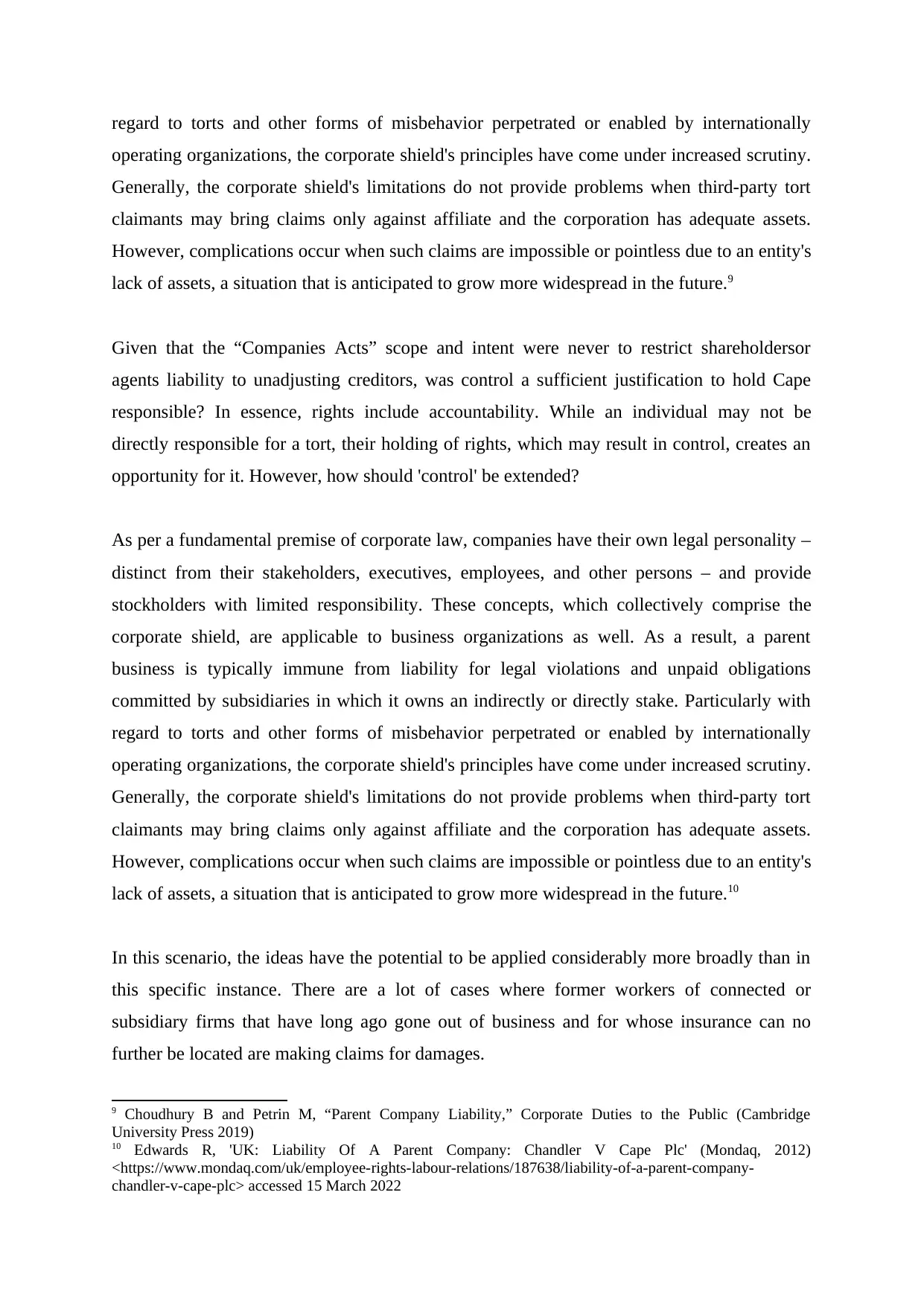
regard to torts and other forms of misbehavior perpetrated or enabled by internationally
operating organizations, the corporate shield's principles have come under increased scrutiny.
Generally, the corporate shield's limitations do not provide problems when third-party tort
claimants may bring claims only against affiliate and the corporation has adequate assets.
However, complications occur when such claims are impossible or pointless due to an entity's
lack of assets, a situation that is anticipated to grow more widespread in the future.9
Given that the “Companies Acts” scope and intent were never to restrict shareholdersor
agents liability to unadjusting creditors, was control a sufficient justification to hold Cape
responsible? In essence, rights include accountability. While an individual may not be
directly responsible for a tort, their holding of rights, which may result in control, creates an
opportunity for it. However, how should 'control' be extended?
As per a fundamental premise of corporate law, companies have their own legal personality –
distinct from their stakeholders, executives, employees, and other persons – and provide
stockholders with limited responsibility. These concepts, which collectively comprise the
corporate shield, are applicable to business organizations as well. As a result, a parent
business is typically immune from liability for legal violations and unpaid obligations
committed by subsidiaries in which it owns an indirectly or directly stake. Particularly with
regard to torts and other forms of misbehavior perpetrated or enabled by internationally
operating organizations, the corporate shield's principles have come under increased scrutiny.
Generally, the corporate shield's limitations do not provide problems when third-party tort
claimants may bring claims only against affiliate and the corporation has adequate assets.
However, complications occur when such claims are impossible or pointless due to an entity's
lack of assets, a situation that is anticipated to grow more widespread in the future.10
In this scenario, the ideas have the potential to be applied considerably more broadly than in
this specific instance. There are a lot of cases where former workers of connected or
subsidiary firms that have long ago gone out of business and for whose insurance can no
further be located are making claims for damages.
9 Choudhury B and Petrin M, “Parent Company Liability,” Corporate Duties to the Public (Cambridge
University Press 2019)
10 Edwards R, 'UK: Liability Of A Parent Company: Chandler V Cape Plc' (Mondaq, 2012)
<https://www.mondaq.com/uk/employee-rights-labour-relations/187638/liability-of-a-parent-company-
chandler-v-cape-plc> accessed 15 March 2022
operating organizations, the corporate shield's principles have come under increased scrutiny.
Generally, the corporate shield's limitations do not provide problems when third-party tort
claimants may bring claims only against affiliate and the corporation has adequate assets.
However, complications occur when such claims are impossible or pointless due to an entity's
lack of assets, a situation that is anticipated to grow more widespread in the future.9
Given that the “Companies Acts” scope and intent were never to restrict shareholdersor
agents liability to unadjusting creditors, was control a sufficient justification to hold Cape
responsible? In essence, rights include accountability. While an individual may not be
directly responsible for a tort, their holding of rights, which may result in control, creates an
opportunity for it. However, how should 'control' be extended?
As per a fundamental premise of corporate law, companies have their own legal personality –
distinct from their stakeholders, executives, employees, and other persons – and provide
stockholders with limited responsibility. These concepts, which collectively comprise the
corporate shield, are applicable to business organizations as well. As a result, a parent
business is typically immune from liability for legal violations and unpaid obligations
committed by subsidiaries in which it owns an indirectly or directly stake. Particularly with
regard to torts and other forms of misbehavior perpetrated or enabled by internationally
operating organizations, the corporate shield's principles have come under increased scrutiny.
Generally, the corporate shield's limitations do not provide problems when third-party tort
claimants may bring claims only against affiliate and the corporation has adequate assets.
However, complications occur when such claims are impossible or pointless due to an entity's
lack of assets, a situation that is anticipated to grow more widespread in the future.10
In this scenario, the ideas have the potential to be applied considerably more broadly than in
this specific instance. There are a lot of cases where former workers of connected or
subsidiary firms that have long ago gone out of business and for whose insurance can no
further be located are making claims for damages.
9 Choudhury B and Petrin M, “Parent Company Liability,” Corporate Duties to the Public (Cambridge
University Press 2019)
10 Edwards R, 'UK: Liability Of A Parent Company: Chandler V Cape Plc' (Mondaq, 2012)
<https://www.mondaq.com/uk/employee-rights-labour-relations/187638/liability-of-a-parent-company-
chandler-v-cape-plc> accessed 15 March 2022
Secure Best Marks with AI Grader
Need help grading? Try our AI Grader for instant feedback on your assignments.
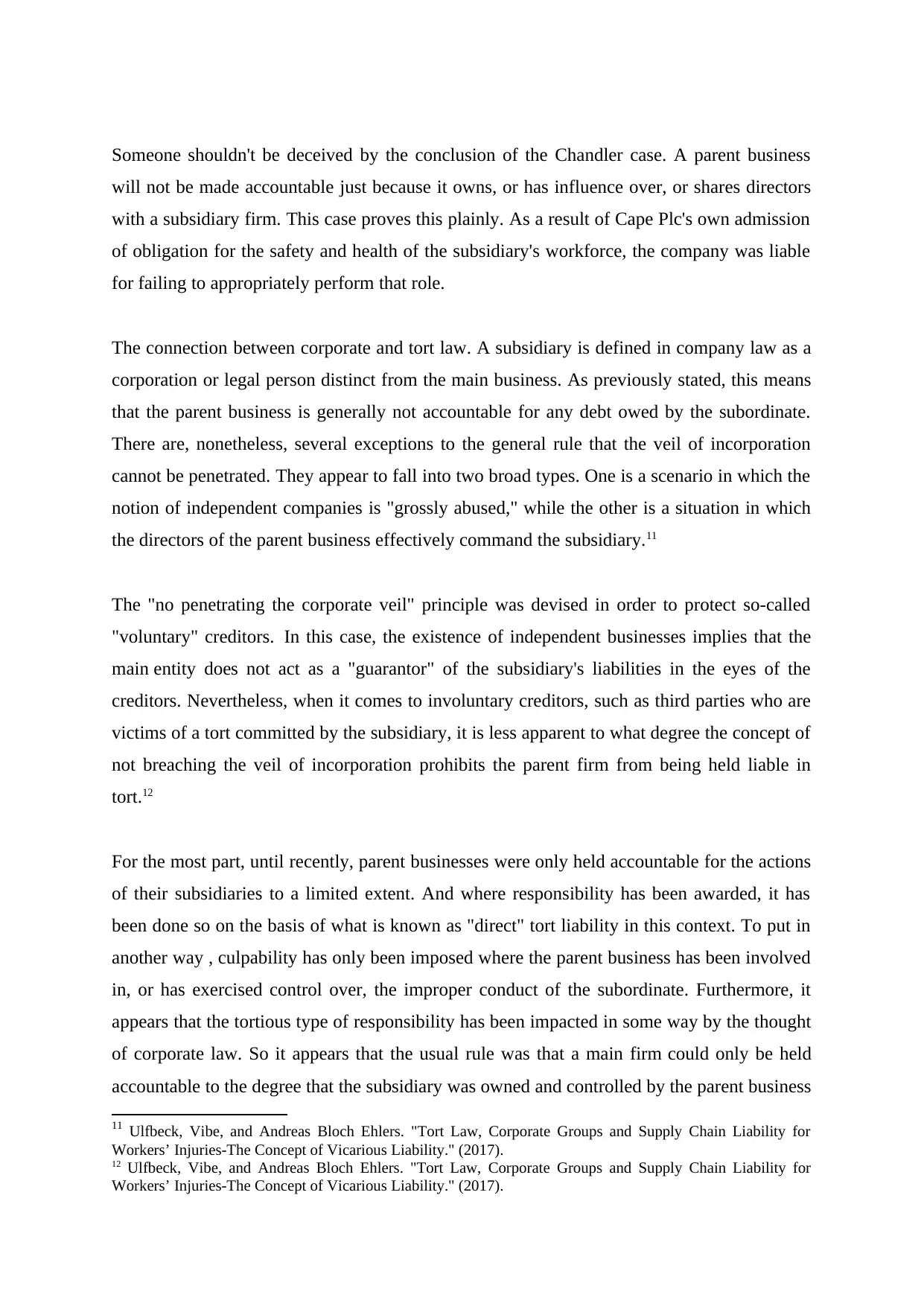
Someone shouldn't be deceived by the conclusion of the Chandler case. A parent business
will not be made accountable just because it owns, or has influence over, or shares directors
with a subsidiary firm. This case proves this plainly. As a result of Cape Plc's own admission
of obligation for the safety and health of the subsidiary's workforce, the company was liable
for failing to appropriately perform that role.
The connection between corporate and tort law. A subsidiary is defined in company law as a
corporation or legal person distinct from the main business. As previously stated, this means
that the parent business is generally not accountable for any debt owed by the subordinate.
There are, nonetheless, several exceptions to the general rule that the veil of incorporation
cannot be penetrated. They appear to fall into two broad types. One is a scenario in which the
notion of independent companies is "grossly abused," while the other is a situation in which
the directors of the parent business effectively command the subsidiary.11
The "no penetrating the corporate veil" principle was devised in order to protect so-called
"voluntary" creditors. In this case, the existence of independent businesses implies that the
main entity does not act as a "guarantor" of the subsidiary's liabilities in the eyes of the
creditors. Nevertheless, when it comes to involuntary creditors, such as third parties who are
victims of a tort committed by the subsidiary, it is less apparent to what degree the concept of
not breaching the veil of incorporation prohibits the parent firm from being held liable in
tort.12
For the most part, until recently, parent businesses were only held accountable for the actions
of their subsidiaries to a limited extent. And where responsibility has been awarded, it has
been done so on the basis of what is known as "direct" tort liability in this context. To put in
another way , culpability has only been imposed where the parent business has been involved
in, or has exercised control over, the improper conduct of the subordinate. Furthermore, it
appears that the tortious type of responsibility has been impacted in some way by the thought
of corporate law. So it appears that the usual rule was that a main firm could only be held
accountable to the degree that the subsidiary was owned and controlled by the parent business
11 Ulfbeck, Vibe, and Andreas Bloch Ehlers. "Tort Law, Corporate Groups and Supply Chain Liability for
Workers’ Injuries-The Concept of Vicarious Liability." (2017).
12 Ulfbeck, Vibe, and Andreas Bloch Ehlers. "Tort Law, Corporate Groups and Supply Chain Liability for
Workers’ Injuries-The Concept of Vicarious Liability." (2017).
will not be made accountable just because it owns, or has influence over, or shares directors
with a subsidiary firm. This case proves this plainly. As a result of Cape Plc's own admission
of obligation for the safety and health of the subsidiary's workforce, the company was liable
for failing to appropriately perform that role.
The connection between corporate and tort law. A subsidiary is defined in company law as a
corporation or legal person distinct from the main business. As previously stated, this means
that the parent business is generally not accountable for any debt owed by the subordinate.
There are, nonetheless, several exceptions to the general rule that the veil of incorporation
cannot be penetrated. They appear to fall into two broad types. One is a scenario in which the
notion of independent companies is "grossly abused," while the other is a situation in which
the directors of the parent business effectively command the subsidiary.11
The "no penetrating the corporate veil" principle was devised in order to protect so-called
"voluntary" creditors. In this case, the existence of independent businesses implies that the
main entity does not act as a "guarantor" of the subsidiary's liabilities in the eyes of the
creditors. Nevertheless, when it comes to involuntary creditors, such as third parties who are
victims of a tort committed by the subsidiary, it is less apparent to what degree the concept of
not breaching the veil of incorporation prohibits the parent firm from being held liable in
tort.12
For the most part, until recently, parent businesses were only held accountable for the actions
of their subsidiaries to a limited extent. And where responsibility has been awarded, it has
been done so on the basis of what is known as "direct" tort liability in this context. To put in
another way , culpability has only been imposed where the parent business has been involved
in, or has exercised control over, the improper conduct of the subordinate. Furthermore, it
appears that the tortious type of responsibility has been impacted in some way by the thought
of corporate law. So it appears that the usual rule was that a main firm could only be held
accountable to the degree that the subsidiary was owned and controlled by the parent business
11 Ulfbeck, Vibe, and Andreas Bloch Ehlers. "Tort Law, Corporate Groups and Supply Chain Liability for
Workers’ Injuries-The Concept of Vicarious Liability." (2017).
12 Ulfbeck, Vibe, and Andreas Bloch Ehlers. "Tort Law, Corporate Groups and Supply Chain Liability for
Workers’ Injuries-The Concept of Vicarious Liability." (2017).
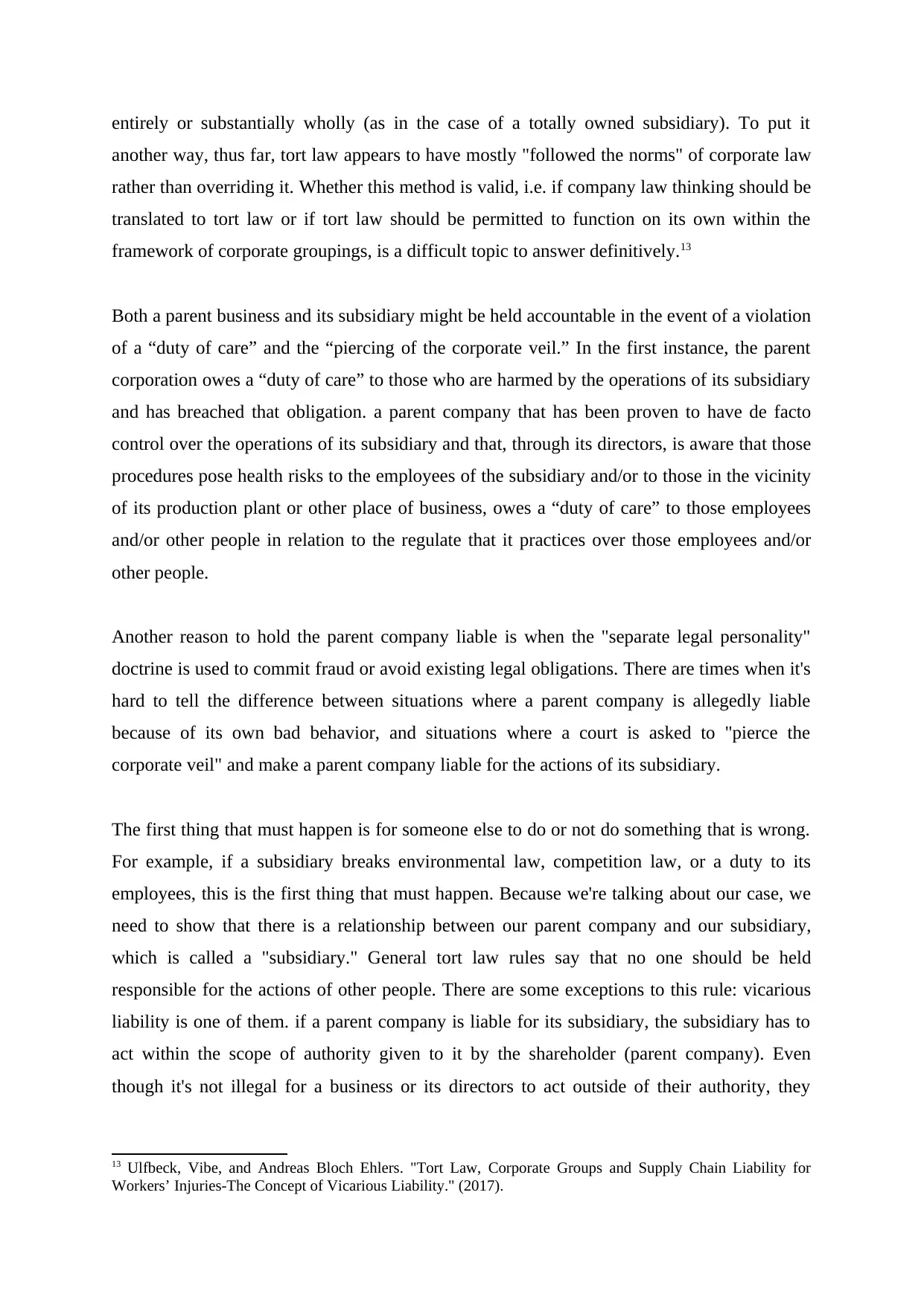
entirely or substantially wholly (as in the case of a totally owned subsidiary). To put it
another way, thus far, tort law appears to have mostly "followed the norms" of corporate law
rather than overriding it. Whether this method is valid, i.e. if company law thinking should be
translated to tort law or if tort law should be permitted to function on its own within the
framework of corporate groupings, is a difficult topic to answer definitively.13
Both a parent business and its subsidiary might be held accountable in the event of a violation
of a “duty of care” and the “piercing of the corporate veil.” In the first instance, the parent
corporation owes a “duty of care” to those who are harmed by the operations of its subsidiary
and has breached that obligation. a parent company that has been proven to have de facto
control over the operations of its subsidiary and that, through its directors, is aware that those
procedures pose health risks to the employees of the subsidiary and/or to those in the vicinity
of its production plant or other place of business, owes a “duty of care” to those employees
and/or other people in relation to the regulate that it practices over those employees and/or
other people.
Another reason to hold the parent company liable is when the "separate legal personality"
doctrine is used to commit fraud or avoid existing legal obligations. There are times when it's
hard to tell the difference between situations where a parent company is allegedly liable
because of its own bad behavior, and situations where a court is asked to "pierce the
corporate veil" and make a parent company liable for the actions of its subsidiary.
The first thing that must happen is for someone else to do or not do something that is wrong.
For example, if a subsidiary breaks environmental law, competition law, or a duty to its
employees, this is the first thing that must happen. Because we're talking about our case, we
need to show that there is a relationship between our parent company and our subsidiary,
which is called a "subsidiary." General tort law rules say that no one should be held
responsible for the actions of other people. There are some exceptions to this rule: vicarious
liability is one of them. if a parent company is liable for its subsidiary, the subsidiary has to
act within the scope of authority given to it by the shareholder (parent company). Even
though it's not illegal for a business or its directors to act outside of their authority, they
13 Ulfbeck, Vibe, and Andreas Bloch Ehlers. "Tort Law, Corporate Groups and Supply Chain Liability for
Workers’ Injuries-The Concept of Vicarious Liability." (2017).
another way, thus far, tort law appears to have mostly "followed the norms" of corporate law
rather than overriding it. Whether this method is valid, i.e. if company law thinking should be
translated to tort law or if tort law should be permitted to function on its own within the
framework of corporate groupings, is a difficult topic to answer definitively.13
Both a parent business and its subsidiary might be held accountable in the event of a violation
of a “duty of care” and the “piercing of the corporate veil.” In the first instance, the parent
corporation owes a “duty of care” to those who are harmed by the operations of its subsidiary
and has breached that obligation. a parent company that has been proven to have de facto
control over the operations of its subsidiary and that, through its directors, is aware that those
procedures pose health risks to the employees of the subsidiary and/or to those in the vicinity
of its production plant or other place of business, owes a “duty of care” to those employees
and/or other people in relation to the regulate that it practices over those employees and/or
other people.
Another reason to hold the parent company liable is when the "separate legal personality"
doctrine is used to commit fraud or avoid existing legal obligations. There are times when it's
hard to tell the difference between situations where a parent company is allegedly liable
because of its own bad behavior, and situations where a court is asked to "pierce the
corporate veil" and make a parent company liable for the actions of its subsidiary.
The first thing that must happen is for someone else to do or not do something that is wrong.
For example, if a subsidiary breaks environmental law, competition law, or a duty to its
employees, this is the first thing that must happen. Because we're talking about our case, we
need to show that there is a relationship between our parent company and our subsidiary,
which is called a "subsidiary." General tort law rules say that no one should be held
responsible for the actions of other people. There are some exceptions to this rule: vicarious
liability is one of them. if a parent company is liable for its subsidiary, the subsidiary has to
act within the scope of authority given to it by the shareholder (parent company). Even
though it's not illegal for a business or its directors to act outside of their authority, they
13 Ulfbeck, Vibe, and Andreas Bloch Ehlers. "Tort Law, Corporate Groups and Supply Chain Liability for
Workers’ Injuries-The Concept of Vicarious Liability." (2017).
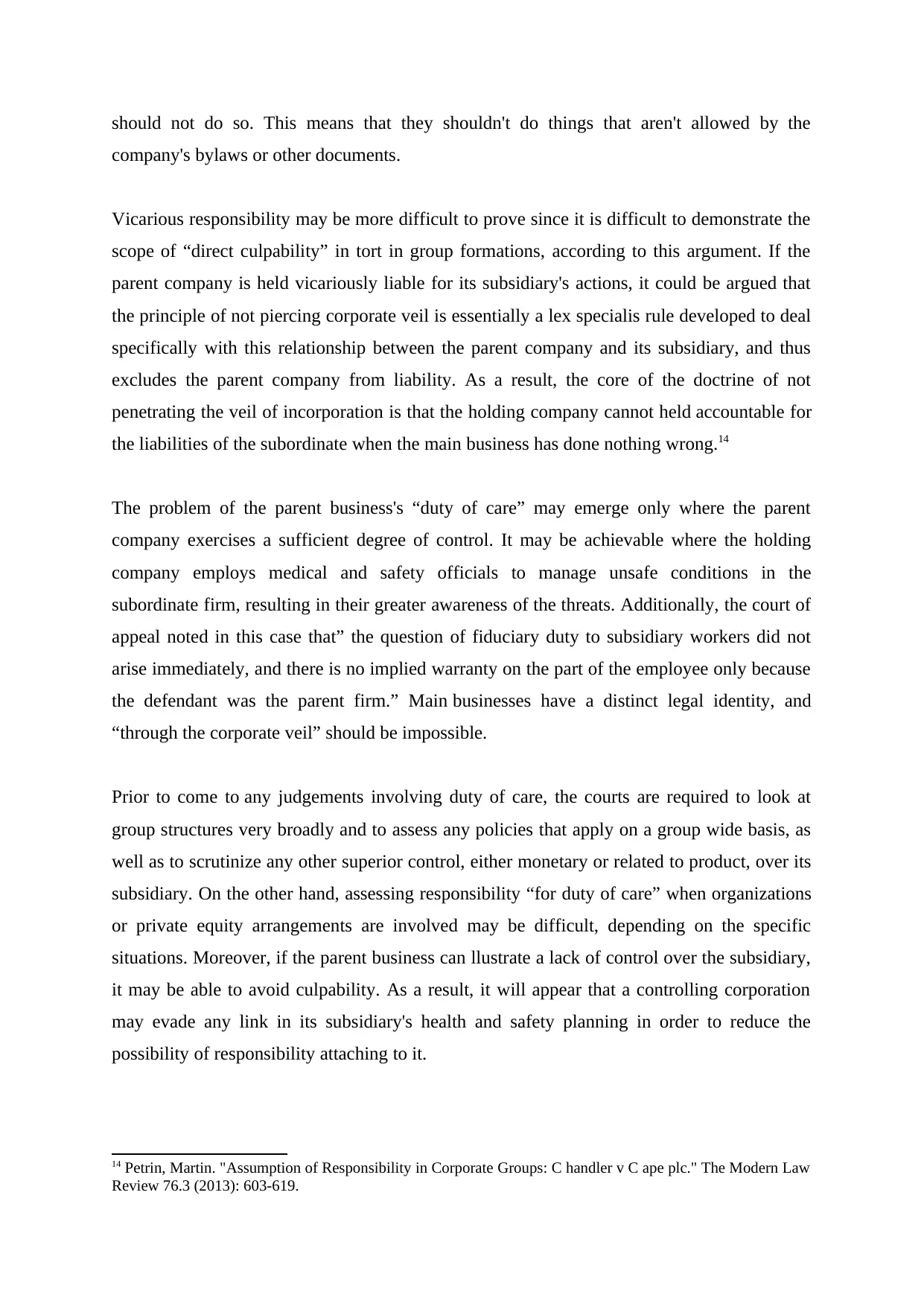
should not do so. This means that they shouldn't do things that aren't allowed by the
company's bylaws or other documents.
Vicarious responsibility may be more difficult to prove since it is difficult to demonstrate the
scope of “direct culpability” in tort in group formations, according to this argument. If the
parent company is held vicariously liable for its subsidiary's actions, it could be argued that
the principle of not piercing corporate veil is essentially a lex specialis rule developed to deal
specifically with this relationship between the parent company and its subsidiary, and thus
excludes the parent company from liability. As a result, the core of the doctrine of not
penetrating the veil of incorporation is that the holding company cannot held accountable for
the liabilities of the subordinate when the main business has done nothing wrong.14
The problem of the parent business's “duty of care” may emerge only where the parent
company exercises a sufficient degree of control. It may be achievable where the holding
company employs medical and safety officials to manage unsafe conditions in the
subordinate firm, resulting in their greater awareness of the threats. Additionally, the court of
appeal noted in this case that” the question of fiduciary duty to subsidiary workers did not
arise immediately, and there is no implied warranty on the part of the employee only because
the defendant was the parent firm.” Main businesses have a distinct legal identity, and
“through the corporate veil” should be impossible.
Prior to come to any judgements involving duty of care, the courts are required to look at
group structures very broadly and to assess any policies that apply on a group wide basis, as
well as to scrutinize any other superior control, either monetary or related to product, over its
subsidiary. On the other hand, assessing responsibility “for duty of care” when organizations
or private equity arrangements are involved may be difficult, depending on the specific
situations. Moreover, if the parent business can llustrate a lack of control over the subsidiary,
it may be able to avoid culpability. As a result, it will appear that a controlling corporation
may evade any link in its subsidiary's health and safety planning in order to reduce the
possibility of responsibility attaching to it.
14 Petrin, Martin. "Assumption of Responsibility in Corporate Groups: C handler v C ape plc." The Modern Law
Review 76.3 (2013): 603-619.
company's bylaws or other documents.
Vicarious responsibility may be more difficult to prove since it is difficult to demonstrate the
scope of “direct culpability” in tort in group formations, according to this argument. If the
parent company is held vicariously liable for its subsidiary's actions, it could be argued that
the principle of not piercing corporate veil is essentially a lex specialis rule developed to deal
specifically with this relationship between the parent company and its subsidiary, and thus
excludes the parent company from liability. As a result, the core of the doctrine of not
penetrating the veil of incorporation is that the holding company cannot held accountable for
the liabilities of the subordinate when the main business has done nothing wrong.14
The problem of the parent business's “duty of care” may emerge only where the parent
company exercises a sufficient degree of control. It may be achievable where the holding
company employs medical and safety officials to manage unsafe conditions in the
subordinate firm, resulting in their greater awareness of the threats. Additionally, the court of
appeal noted in this case that” the question of fiduciary duty to subsidiary workers did not
arise immediately, and there is no implied warranty on the part of the employee only because
the defendant was the parent firm.” Main businesses have a distinct legal identity, and
“through the corporate veil” should be impossible.
Prior to come to any judgements involving duty of care, the courts are required to look at
group structures very broadly and to assess any policies that apply on a group wide basis, as
well as to scrutinize any other superior control, either monetary or related to product, over its
subsidiary. On the other hand, assessing responsibility “for duty of care” when organizations
or private equity arrangements are involved may be difficult, depending on the specific
situations. Moreover, if the parent business can llustrate a lack of control over the subsidiary,
it may be able to avoid culpability. As a result, it will appear that a controlling corporation
may evade any link in its subsidiary's health and safety planning in order to reduce the
possibility of responsibility attaching to it.
14 Petrin, Martin. "Assumption of Responsibility in Corporate Groups: C handler v C ape plc." The Modern Law
Review 76.3 (2013): 603-619.
Paraphrase This Document
Need a fresh take? Get an instant paraphrase of this document with our AI Paraphraser
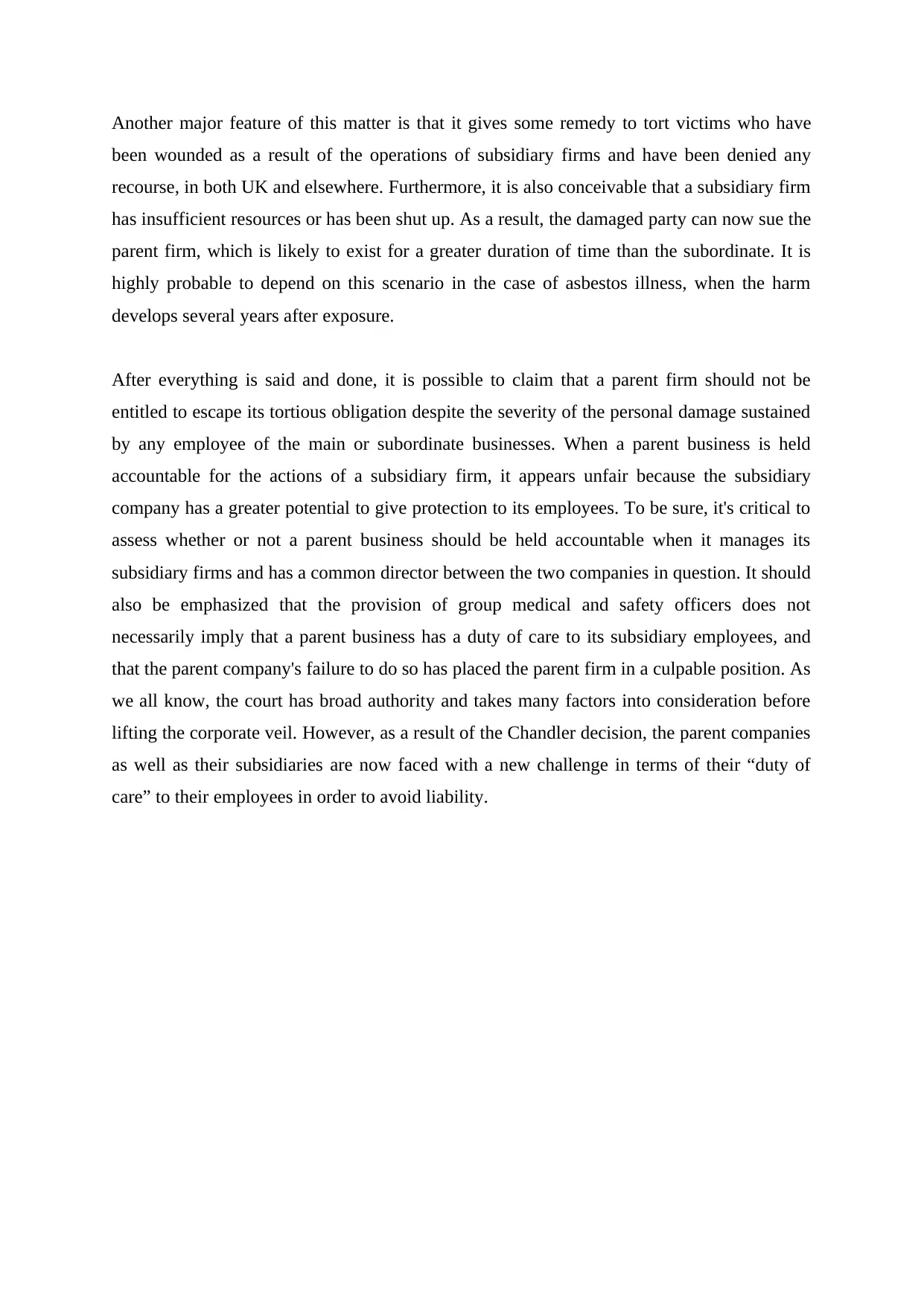
Another major feature of this matter is that it gives some remedy to tort victims who have
been wounded as a result of the operations of subsidiary firms and have been denied any
recourse, in both UK and elsewhere. Furthermore, it is also conceivable that a subsidiary firm
has insufficient resources or has been shut up. As a result, the damaged party can now sue the
parent firm, which is likely to exist for a greater duration of time than the subordinate. It is
highly probable to depend on this scenario in the case of asbestos illness, when the harm
develops several years after exposure.
After everything is said and done, it is possible to claim that a parent firm should not be
entitled to escape its tortious obligation despite the severity of the personal damage sustained
by any employee of the main or subordinate businesses. When a parent business is held
accountable for the actions of a subsidiary firm, it appears unfair because the subsidiary
company has a greater potential to give protection to its employees. To be sure, it's critical to
assess whether or not a parent business should be held accountable when it manages its
subsidiary firms and has a common director between the two companies in question. It should
also be emphasized that the provision of group medical and safety officers does not
necessarily imply that a parent business has a duty of care to its subsidiary employees, and
that the parent company's failure to do so has placed the parent firm in a culpable position. As
we all know, the court has broad authority and takes many factors into consideration before
lifting the corporate veil. However, as a result of the Chandler decision, the parent companies
as well as their subsidiaries are now faced with a new challenge in terms of their “duty of
care” to their employees in order to avoid liability.
been wounded as a result of the operations of subsidiary firms and have been denied any
recourse, in both UK and elsewhere. Furthermore, it is also conceivable that a subsidiary firm
has insufficient resources or has been shut up. As a result, the damaged party can now sue the
parent firm, which is likely to exist for a greater duration of time than the subordinate. It is
highly probable to depend on this scenario in the case of asbestos illness, when the harm
develops several years after exposure.
After everything is said and done, it is possible to claim that a parent firm should not be
entitled to escape its tortious obligation despite the severity of the personal damage sustained
by any employee of the main or subordinate businesses. When a parent business is held
accountable for the actions of a subsidiary firm, it appears unfair because the subsidiary
company has a greater potential to give protection to its employees. To be sure, it's critical to
assess whether or not a parent business should be held accountable when it manages its
subsidiary firms and has a common director between the two companies in question. It should
also be emphasized that the provision of group medical and safety officers does not
necessarily imply that a parent business has a duty of care to its subsidiary employees, and
that the parent company's failure to do so has placed the parent firm in a culpable position. As
we all know, the court has broad authority and takes many factors into consideration before
lifting the corporate veil. However, as a result of the Chandler decision, the parent companies
as well as their subsidiaries are now faced with a new challenge in terms of their “duty of
care” to their employees in order to avoid liability.
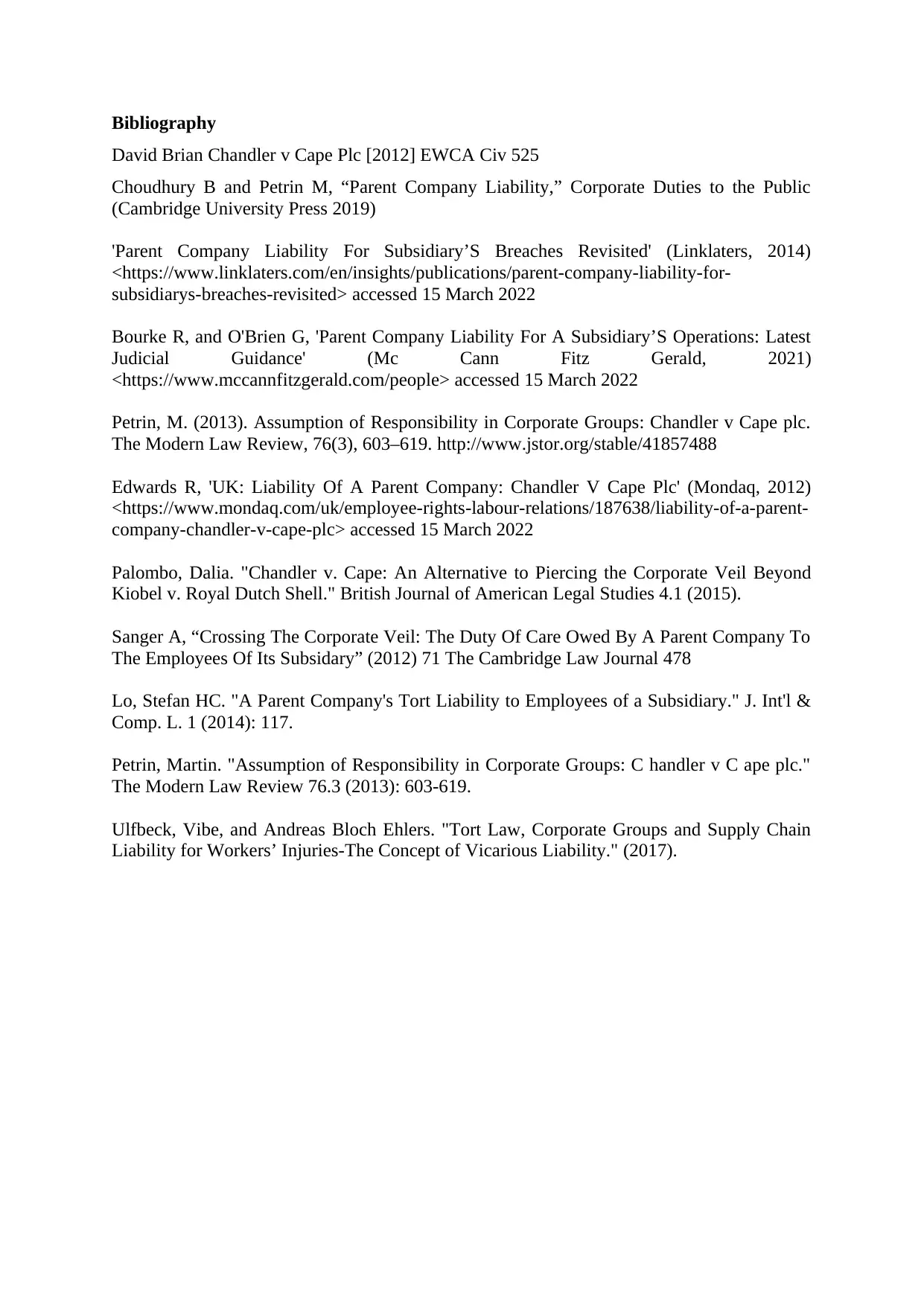
Bibliography
David Brian Chandler v Cape Plc [2012] EWCA Civ 525
Choudhury B and Petrin M, “Parent Company Liability,” Corporate Duties to the Public
(Cambridge University Press 2019)
'Parent Company Liability For Subsidiary’S Breaches Revisited' (Linklaters, 2014)
<https://www.linklaters.com/en/insights/publications/parent-company-liability-for-
subsidiarys-breaches-revisited> accessed 15 March 2022
Bourke R, and O'Brien G, 'Parent Company Liability For A Subsidiary’S Operations: Latest
Judicial Guidance' (Mc Cann Fitz Gerald, 2021)
<https://www.mccannfitzgerald.com/people> accessed 15 March 2022
Petrin, M. (2013). Assumption of Responsibility in Corporate Groups: Chandler v Cape plc.
The Modern Law Review, 76(3), 603–619. http://www.jstor.org/stable/41857488
Edwards R, 'UK: Liability Of A Parent Company: Chandler V Cape Plc' (Mondaq, 2012)
<https://www.mondaq.com/uk/employee-rights-labour-relations/187638/liability-of-a-parent-
company-chandler-v-cape-plc> accessed 15 March 2022
Palombo, Dalia. "Chandler v. Cape: An Alternative to Piercing the Corporate Veil Beyond
Kiobel v. Royal Dutch Shell." British Journal of American Legal Studies 4.1 (2015).
Sanger A, “Crossing The Corporate Veil: The Duty Of Care Owed By A Parent Company To
The Employees Of Its Subsidary” (2012) 71 The Cambridge Law Journal 478
Lo, Stefan HC. "A Parent Company's Tort Liability to Employees of a Subsidiary." J. Int'l &
Comp. L. 1 (2014): 117.
Petrin, Martin. "Assumption of Responsibility in Corporate Groups: C handler v C ape plc."
The Modern Law Review 76.3 (2013): 603-619.
Ulfbeck, Vibe, and Andreas Bloch Ehlers. "Tort Law, Corporate Groups and Supply Chain
Liability for Workers’ Injuries-The Concept of Vicarious Liability." (2017).
David Brian Chandler v Cape Plc [2012] EWCA Civ 525
Choudhury B and Petrin M, “Parent Company Liability,” Corporate Duties to the Public
(Cambridge University Press 2019)
'Parent Company Liability For Subsidiary’S Breaches Revisited' (Linklaters, 2014)
<https://www.linklaters.com/en/insights/publications/parent-company-liability-for-
subsidiarys-breaches-revisited> accessed 15 March 2022
Bourke R, and O'Brien G, 'Parent Company Liability For A Subsidiary’S Operations: Latest
Judicial Guidance' (Mc Cann Fitz Gerald, 2021)
<https://www.mccannfitzgerald.com/people> accessed 15 March 2022
Petrin, M. (2013). Assumption of Responsibility in Corporate Groups: Chandler v Cape plc.
The Modern Law Review, 76(3), 603–619. http://www.jstor.org/stable/41857488
Edwards R, 'UK: Liability Of A Parent Company: Chandler V Cape Plc' (Mondaq, 2012)
<https://www.mondaq.com/uk/employee-rights-labour-relations/187638/liability-of-a-parent-
company-chandler-v-cape-plc> accessed 15 March 2022
Palombo, Dalia. "Chandler v. Cape: An Alternative to Piercing the Corporate Veil Beyond
Kiobel v. Royal Dutch Shell." British Journal of American Legal Studies 4.1 (2015).
Sanger A, “Crossing The Corporate Veil: The Duty Of Care Owed By A Parent Company To
The Employees Of Its Subsidary” (2012) 71 The Cambridge Law Journal 478
Lo, Stefan HC. "A Parent Company's Tort Liability to Employees of a Subsidiary." J. Int'l &
Comp. L. 1 (2014): 117.
Petrin, Martin. "Assumption of Responsibility in Corporate Groups: C handler v C ape plc."
The Modern Law Review 76.3 (2013): 603-619.
Ulfbeck, Vibe, and Andreas Bloch Ehlers. "Tort Law, Corporate Groups and Supply Chain
Liability for Workers’ Injuries-The Concept of Vicarious Liability." (2017).
1 out of 9
Your All-in-One AI-Powered Toolkit for Academic Success.
+13062052269
info@desklib.com
Available 24*7 on WhatsApp / Email
![[object Object]](/_next/static/media/star-bottom.7253800d.svg)
Unlock your academic potential
© 2024 | Zucol Services PVT LTD | All rights reserved.